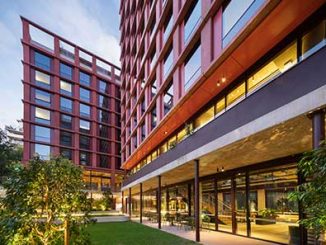Sydney, once celebrated as one of the world’s most liveable cities, is quietly closing its doors to young people. Soaring rents, shrinking housing options, and mounting financial pressure are pushing many into survival mode. Commutes have stretched longer, part-time work hours are piling up, and sudden terminations by landlords are no longer rare. For some, even finding the next roof over their heads has become a daunting task. Rents are rising, but space — both physical and emotional — is running out.
Jasmine Liu, a 22-year-old international student at the University of Sydney, is one of many struggling to find stability amid Sydney’s housing crisis. She currently shares a flat in Parramatta with three roommates, paying $350 a week. To make ends meet, she juggles an unpaid internship in the CBD and food delivery shifts, often working over 20 hours a week — yet she says, “barely gets by.”
“Every time I see another rent increase notice, my heart races,” she says.
“I commute nearly two hours a day, sometimes skip meals, and still, my rental applications are constantly rejected. I feel pushed to the city’s edges, socially and academically.”
A crisis felt across a generation
Jasmine’s story is far from unique. A growing number of Sydney’s young renters are facing crushing housing costs and unstable living arrangements — with little institutional support.
According to CoreLogic’s April 2024 figures, the average weekly rent in Sydney has reached a record high of approximately $770. Nationally, rents have increased by 8.5% year-on-year, outpacing wage growth and exacerbating rental affordability pressures. The ABS reports that while full-time adults earned an average of $1,975.80 per week as of November 2024 (up just 4.6%), many young people — especially students — earn far less and are spending disproportionate amounts of their income on rent. This sharp rise mirrors Jasmine’s experience, whose weekly rent alone consumes nearly half her income.
Homelessness Australia estimates that those on Youth Allowance may spend up to 94% of their income on rent — more than three times the benchmark for housing stress.
The “invisible” victims: students left behind
Though the NSW government has pledged to build more affordable housing and ease planning approvals, students like Jasmine say the impact is nowhere to be felt.
“I had to move out within two weeks last year when my landlord sold the property,” Jasmine says. “There was nothing I could afford, so I ended up taking a unit that was $200 over my budget. I had less than $300 to live on for the month. I couldn’t sleep. I was studying while searching for houses on Facebook Marketplace. I nearly broke down.”
A 2023 survey by Mission Australia highlighted that housing affordability and homelessness are significant concerns among young Australians, contributing to increased levels of anxiety, particularly for those living alone or facing frequent relocations.
No place to call home
The 2024 Rental Affordability Snapshot by Anglicare Australia paints a bleak picture: in Sydney, only 0.6% of listings are affordable for someone on full-time minimum wage. For Youth Allowance recipients, options are virtually non-existent.
“Sydney’s rental market is deteriorating rapidly,” says Shelter NSW chief executive John Engeler. “Rent increases are outpacing wages, pushing young people into severe financial and psychological stress.”
Shelter NSW reports that Sydney’s rental affordability has dropped 23% over the past three years, and that more than half of young renters are under “significant strain”.
Mental health hit: ‘I just couldn’t cope’
The financial burden is only one layer of the crisis. The psychological impact is growing.
A 2024 youth survey by Monash University found that 98% of 18–24-year-olds reported experiencing anxiety or pessimism in the past year, with 73% identifying housing affordability as one of the top three issues needing urgent action.
Furthermore, data from Beyond Blue reveals that 34% of respondents identified housing stress and challenges in personal relationships as significant sources of their distress. Financial constraints can make it difficult for students to access mental health support, sometimes forcing difficult trade-offs between essentials like food or transport.
“I felt completely alone,” Jasmine says. “Even when I had work, I was always on edge — thinking about the next move, the next bill. It’s like there’s no space for us in this city.”
International students: priced out and isolated
International students are among the worst affected. According to The Guardian’s own September 2024 report, some students pay up to $800 a fortnight for accommodation, without access to housing subsidies or full working rights.
Many students are facing financial pressures due to Sydney’s high cost of living. This ongoing challenge could pose risks to Sydney’s reputation as a leading global education hub in the long term.
Policy promises and the delivery gap
In 2023, the Australian government launched a National Housing Accord, promising 1.2 million homes over five years. But most of this support is directed at first-home buyers and low-income families — not students.
CBRE’s 2024 student housing report predicts an 18% increase in PBSA beds by 2027 — a gain of just 19,000 beds, insufficient for the growing student population.
While the Accord lays out long-term goals to boost housing supply and support home ownership, it offers few short-term measures targeting students or young renters. According to the Grattan Institute, without targeted rent relief or reforms to investor incentives, younger renters will continue to be priced out despite long-term commitments.
In the cracks, a new community emerges
Despite the grim landscape, young people are finding solidarity in creative ways. Digital forums like the Facebook group Sharehouse Sydney — with over 200,000 members — have become grassroots housing networks where students share listings and support.
Organisations such as Newtown Neighbourhood Centre offer legal advice, crisis accommodation, and mental health support to fill institutional gaps.
‘We can’t fix the market, but we can build community’
“We may not be able to fix the housing crisis,” Jasmine says, “but we can create a place where we understand and support each other.”
In shared kitchens, late-night chats, and long commutes, young renters in Sydney are quietly rebuilding a sense of home. Their stories highlight a deeper truth: a truly livable city isn’t measured only by infrastructure or rental indexes — but by whether its young people can live, study, and dream with dignity.




Be the first to comment